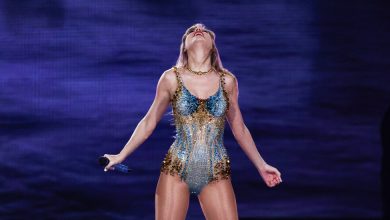‘I Feel an Abundance’: A Composer Dips Into the Dance World

“Arrghh, the pressure!” exclaimed the composer Lido Pimienta, after being told that she and the choreographer Andrea Miller were the first all-female team to be commissioned to create a piece for New York City Ballet.
When that dance, “sky to hold,” with costumes by Esteban Cortázar, debuts at the company’s fall fashion gala on Thursday night, both women will be breaking new ground. For Miller, a contemporary choreographer who danced with the Batsheva Ensemble in Israel before founding her New York company, Gallim Dance, it will be the first time she has created a piece on pointe. And for Pimienta, a Canadian-Columbian singer-songwriter whose music incorporates Indigenous, Afro-Columbian and electronic elements, “sky to hold” is her first theatrical score.
And more ground broken: Pimienta, who has incorporated her voice and songs, which she will perform live, into the score, is also the first female composer of color to create a piece at City Ballet. The score isn’t the company’s usual fare: it includes vallenato, a popular folk music genre from Colombia, and dembow (“heavy rhythm, very groovy,” Pimienta said) from the Dominican Republic, sometimes making unconventional use of classical instruments like the harp.
Most of the collaboration between Miller, who lives in New Haven, and Pimienta, who lives in Toronto and London, Ontario, has been done remotely. But last week, Pimienta arrived in New York and at rehearsals.
“It’s pretty cool to have her with us, watching and reacting to us as artists,” said the principal dancer Sara Mearns in a phone interview. “Andrea warned us, know the music, don’t rely solely on her voice because she might not do the same thing every show. I love that; you have to be out there, in the moment.”
In a video interview, with Miller on a train and Pimienta in a temporary apartment, they discussed the evolution of the score and the choreography, and how Pimienta came to be performing in the work. Here are edited excerpts from the conversation.
How did this collaboration come about? Did you know each other?
ANDREA MILLER I told a friend, who was working with Lido at the time, that I had a commission from City Ballet and really wanted to take the music seriously. She said, “Stop right there: It’s Lido Pimienta.” I knew Lido’s music, she is a superstar, so my jaw just dropped. My husband and I, and our kids, listen to her music all the time, and it’s so exciting, so inspiring, you want to dance to it with your headphones on.
LIDO PIMIENTA It’s funny, when Andrea contacted me, I was working on music for my next album and really thinking about orchestration.
It’s my first time doing something this big, and I am always fighting the feeling of impostor syndrome. But I told myself: Even if I have never composed for 66 musicians before, there are 66 channels in the music I produce. If Andrea thinks I’m worthy, it’s fine!
How did you begin? Did you discuss specific ideas, images or musical styles?
PIMIENTA We were communicating constantly and dreaming together. I kept watching Andrea’s work, which was very inspiring for me. My songs are about me and my lived experience, but for this it also had to be about Andrea and the dancers, so I wanted to create a story with the music that we could all tap into.
MILLER It was a specially dark time during the pandemic, and I was thinking of heat, the sun on my face, going dancing with strangers! I was craving the heat of intimacy, of summer, of warmth. I gave Lido a sense of that, and I also let her know which pieces of her music were very inspiring to me.
PIMIENTA My job was to translate those ideas and feelings into music. As someone from Colombia, I know that feeling of the sun hitting your face as you lie in a hammock. That gave me an intro; a feeling of heat, but also of tension.
I am a singer and I would say my work is about storytelling, so once I had that idea, in my head there was this whole movie happening. I thought, I should tell Andrea, so I sat down and wrote and illustrated the story I saw.
It’s about a seed, who falls in love with a storm. To get to light and heat, you go through the storm, and that became the musical thread.
Andrea, how did the evolution of the score affect the development of the choreography?
MILLER Lido is so generous, and had let me listen without telling me how anything should be. But after receiving the story, I had so much more to say and discover. There was something in her story and drawings that reminded me of both the magical realism of Colombia and the symbolism and mysticism of Chagall, whose work I love.
In the ballet, I do have a seed character, Taylor Stanley, and a storm, Sara Mearns, but I’m not worried about it making sense. The shape and feel of it are just there to absorb and take away, like looking at a painting.
Lido, how does it feel to see your work given a visual counterpart?
PIMIENTA It feels potent, it feels extreme — I feel an abundance. When I see the dance responding to the rhythm, the sound, the melody, it’s very emotional for me. I told Andrea, you might have to get another singer, because I might cry throughout the ballet!
Was it always part of the plan that you would sing onstage?
PIMIENTA Never in a million years did I think I would be performing. But after Andrea got the first draft of the score, she said, where is your voice? I thought, OK, I’ll be in the pit, and she said, “We’ll put you onstage and give you some steps.” I said NOOOOO, so the compromise is that I’ll be on the side of the stage.
Now, of course, I’m totally into the fantasy. I had my fitting yesterday, and I thought, how fabulous am I going to be? Maybe I will walk around the stage!
There’s pressure in being the first female composer-choreographer team to create an entirely new work for the company. (Violette Verdy created a dance to an existing score by Mary Jeanne van Appledorn, in 1988.) That’s still noteworthy; are things changing?
MILLER There has been important progress, but I also feel sadness for all the talented women who didn’t get to choreograph or compose or get recognition in their time. And I’m always conscious that when we talk about things turning around, we’re not thinking globally.
PIMIENTA I am South American, Indigenous, Black, brown, an immigrant — sometimes I feel like I am just those boxes being checked off. So to have this support and confidence is just incredible.
It makes me feel sad for this world of classical music and ballet that it’s so remarkable that we are women because in my musical world I mostly work with women. But it’s not just that. Having more people like me is important because there is a class divide, too; people don’t necessarily feel at ease going to a symphony concert or a ballet. It’s a pity. For me, the classical world actually feels very contemporary, very much what is happening now. I want more people to understand how strong and inspiring it can be.



